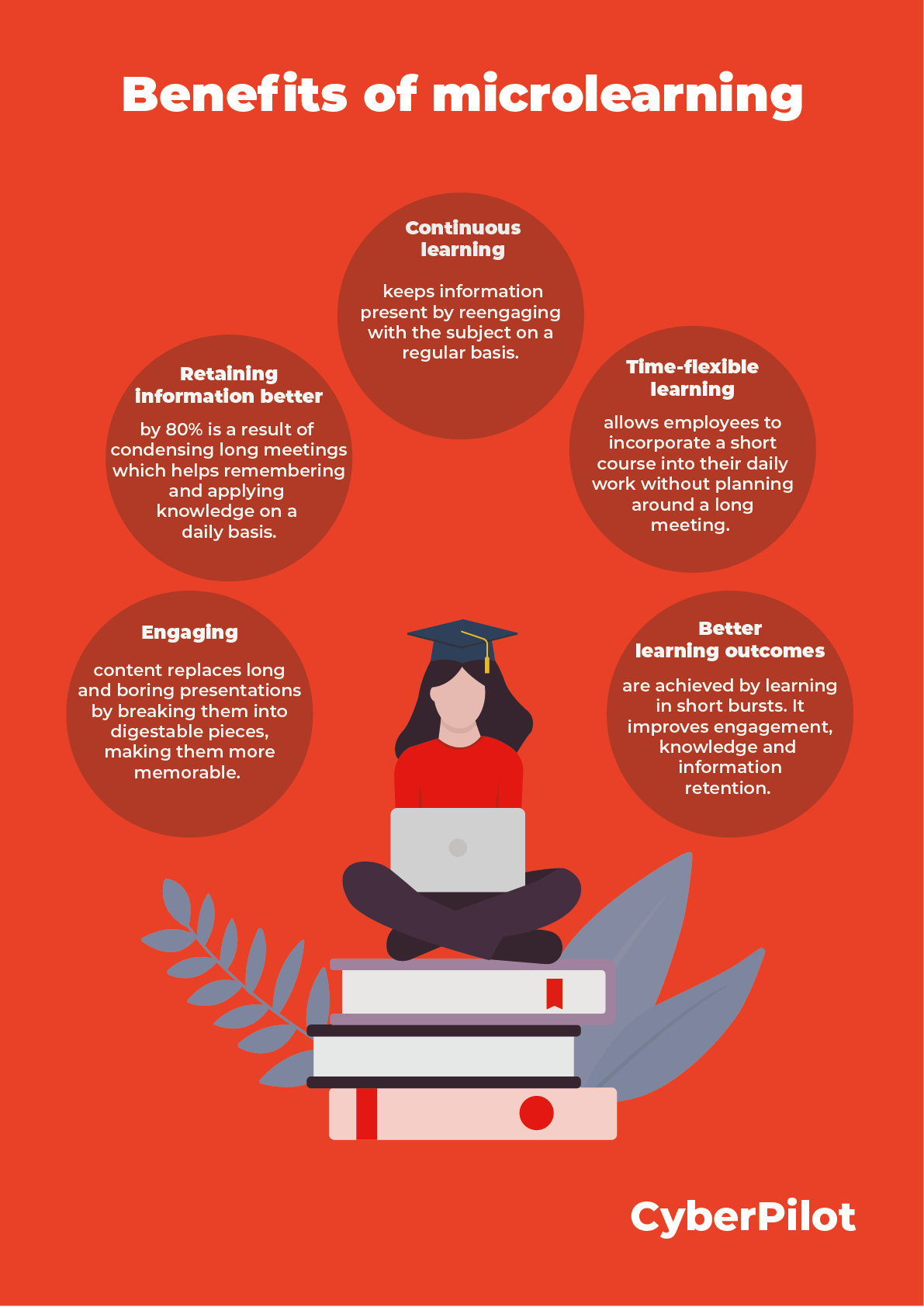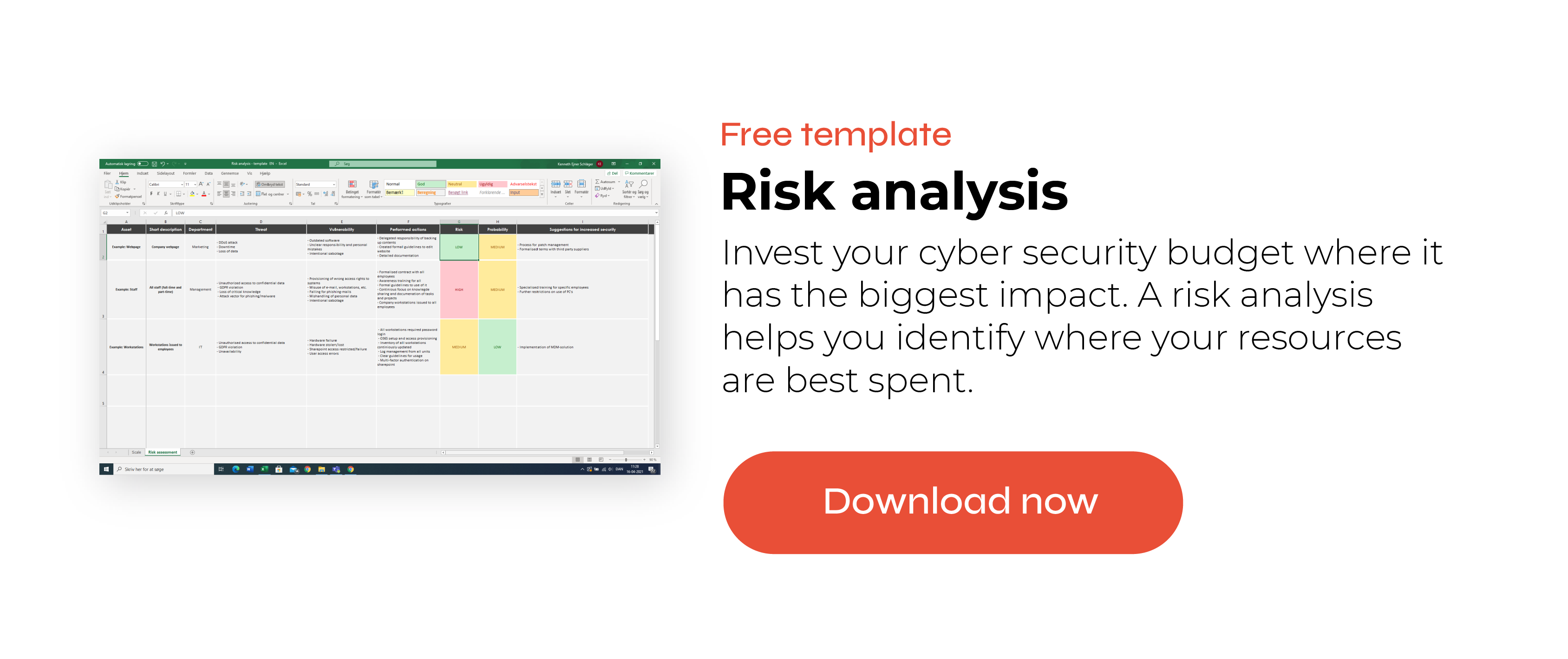You’ve probably sat through one (or many) long, boring trainings on company policies and wondered – is this really necessary? Training that takes a long time to complete, whether it takes place in a big room with the entire company or through an hour-long online course, often harms staff morale and leads to poor learning outcomes. This means that people dread training, avoid it, and are mentally tuned out of the training. Microlearning can fix these common training issues and we even use it in our awareness training at CyberPilot! In this post, we cover what microlearning is and the benefits of using it. We also give some tips on how you can use microlearning in your own security training.
What is microlearning?
To put it simply, microlearning is a way of teaching people new information in small doses, often over a long period of time. The key to microlearning is that new information is broken up into short lessons or learning exercises. Content distributed through microlearning can take many forms, such as short videos or small pieces of text. As long as it takes just a few minutes to complete, it’s microlearning – and it has several benefits.
Listen to our podcast, where we talk about microlearning
Benefits of microlearning
Microlearning as a training style has quickly become popular across organisations. And there’s a good reason for it! The benefits of microlearning are plentiful, such as
-
Continuous learning
-
Not a time burden
-
Engaging
Let’s dive into each one of them.

Continuous learning
Since microlearning happens in short doses, content is usually delivered gradually over time. This means that the information that used to be covered in a 3-hour long staff meeting could be delivered in a series of monthly lessons that take about 10 minutes to complete. Giving information over time relieves the possibility that the audience will be overwhelmed by too much new information. It also keeps the subject top of mind for longer since the audience will reengage with it on a regular basis.
Not a time burden
Time is one of the most important resources employees have. Long meetings that take hours out of a workday can distract employees from their work and put a sour taste in their mouths even before the meeting begins. Microlearning has the advantage of efficiency. Since it only takes a few minutes at a time, it’s easier for people to participate – and want to participate. It can even be a welcome break from their regular work tasks. This kind of training usually does not have a fixed time and date on the calendar. So, people only need to take a few minutes of their time to complete the training and they can choose the time that works best. Instead of having to reschedule 5 different meetings to find time for the training, they can do it when they have a small gap in their schedules.
Engaging
The traditional form of learning, e.g., long lectures to cover a topic, can easily lose the audience after the first 5 minutes. The fact is that nobody wants to sit through a long presentation on information they aren’t that interested in. Microlearning breaks a long learning session into digestible pieces so that the audience remains engaged the entire time. It’s obviously easier to focus on the GDPR for 5 minutes than 1 hour. And since the audience is engaged, they are more likely to remember the information covered.
Better retention of new information
By delivering new information in digestible pieces, microlearning helps the audience remember what was covered in each lesson. Research suggests that microlearning can actually improve information retention by 80%. We are more likely to remember what happened in a 5-minute meeting than an hour-long meeting, during which we might have accidentally zoned out for 40 minutes. Microlearning helps people remember what they learned, meaning they are better equipped to apply their new knowledge in their everyday lives.
Better learning outcomes
Overall, using microlearning leads to better learning outcomes. Since microlearning happens in short bursts, it keeps the audience engaged in the content. Additionally, since microlearning happens over time, it gives you the opportunity to build upon your audience’s knowledge over the course of months and years, so the information remains top of mind.

Microlearning example: How we do it at CyberPilot
Short courses released over time
We know the benefits of microlearning well, so we use microlearning as a key part of our awareness training. For example, our awareness training courses take no more than 5-10 minutes to complete, so they are a quick and easy way to teach good IT security habits. We also don’t overwhelm our users with courses to take, and instead, aim for progressive awareness over time by releasing courses to users once every other month. This way, people don’t get burnt out by too much training.
Content delivered in different formats
To keep our courses engaging, we also mix up the content format. Each e-learning course has three different activities to keep the courses engaging. They start with a short video of a common security scenario, then they have a few slides of short text to explain the topic, and finally they end with a quiz. This format helps users engage in our content and remember the key lessons better.
If you are interested in seeing how we use microlearning in our courses for yourself, you are welcome to sign up for a 14-day free trial of our awareness training.
In addition to our awareness training courses, we also have free posters about IT security and the GDPR that you can hang up in the office. Looking at a poster only takes your colleagues a few seconds, and they serve as a constant reminder of good IT habits.
How to use microlearning in your own awareness training initiatives
So, are you convinced and ready to give microlearning a try in your own training work? It’s not too hard to implement, but it does take some planning. Here are some of our tips for how you can use microlearning in your own security awareness training:
-
Switch from long presentations about security to short presentations or sessions no longer than 10 minutes. You can even use a training partner like CyberPilot to create the content for you.
-
Spread the training out over time. Less content in each session gives you the opportunity to stretch learning out over more time, keeping awareness high throughout the year. Aim for one learning activity at least every other month. Read more about how to design a training program here.
-
Add other elements to your trainings to keep them engaging. You can use gamification, such as a quiz at the end or a competition to see which employee/team has the highest course completion rate. This is called gamified microlearning. Another element you could use is phishing testing, which brings learning into practice with real-time phishing email simulations.
You can also check out our blog post with tips on how to create engaging awareness training for your colleagues. If CyberPilot can help you reach your awareness training goals, please do not hesitate to contact our team.

